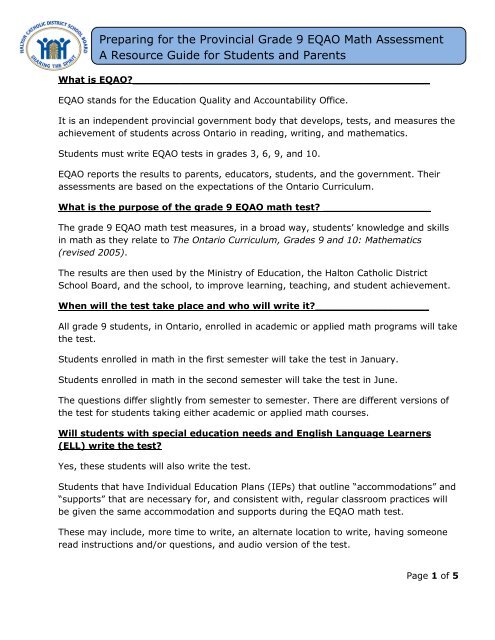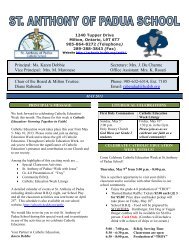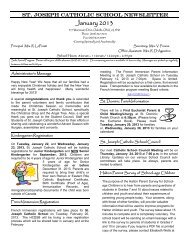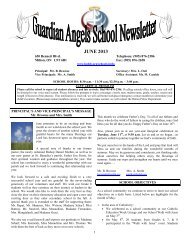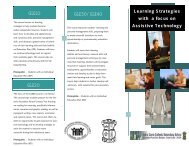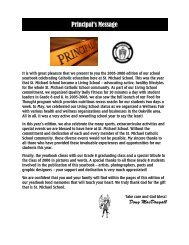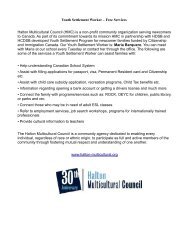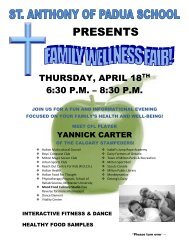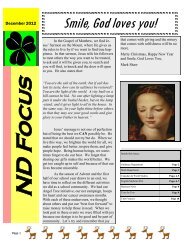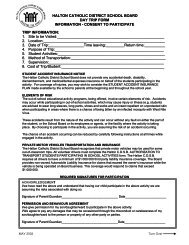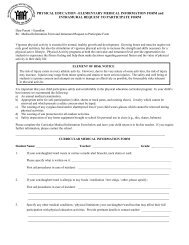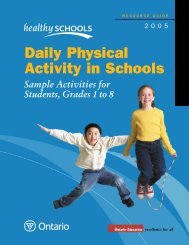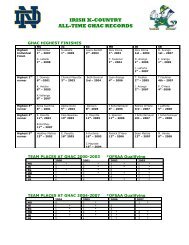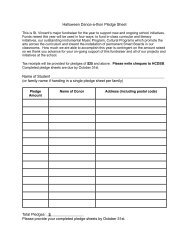Preparing for the Provincial Grade 9 EQAO Math Assessment A ...
Preparing for the Provincial Grade 9 EQAO Math Assessment A ...
Preparing for the Provincial Grade 9 EQAO Math Assessment A ...
Create successful ePaper yourself
Turn your PDF publications into a flip-book with our unique Google optimized e-Paper software.
<strong>Preparing</strong> <strong>for</strong> <strong>the</strong> <strong>Provincial</strong> <strong>Grade</strong> 9 <strong>EQAO</strong> <strong>Math</strong> <strong>Assessment</strong><br />
A Resource Guide <strong>for</strong> Students and Parents<br />
What is <strong>EQAO</strong>?_______________________________________________<br />
<strong>EQAO</strong> stands <strong>for</strong> <strong>the</strong> Education Quality and Accountability Office.<br />
It is an independent provincial government body that develops, tests, and measures <strong>the</strong><br />
achievement of students across Ontario in reading, writing, and ma<strong>the</strong>matics.<br />
Students must write <strong>EQAO</strong> tests in grades 3, 6, 9, and 10.<br />
<strong>EQAO</strong> reports <strong>the</strong> results to parents, educators, students, and <strong>the</strong> government. Their<br />
assessments are based on <strong>the</strong> expectations of <strong>the</strong> Ontario Curriculum.<br />
What is <strong>the</strong> purpose of <strong>the</strong> grade 9 <strong>EQAO</strong> math test? _________________<br />
The grade 9 <strong>EQAO</strong> math test measures, in a broad way, students’ knowledge and skills<br />
in math as <strong>the</strong>y relate to The Ontario Curriculum, <strong>Grade</strong>s 9 and 10: Ma<strong>the</strong>matics<br />
(revised 2005).<br />
The results are <strong>the</strong>n used by <strong>the</strong> Ministry of Education, <strong>the</strong> Halton Catholic District<br />
School Board, and <strong>the</strong> school, to improve learning, teaching, and student achievement.<br />
When will <strong>the</strong> test take place and who will write it?__________________<br />
All grade 9 students, in Ontario, enrolled in academic or applied math programs will take<br />
<strong>the</strong> test.<br />
Students enrolled in math in <strong>the</strong> first semester will take <strong>the</strong> test in January.<br />
Students enrolled in math in <strong>the</strong> second semester will take <strong>the</strong> test in June.<br />
The questions differ slightly from semester to semester. There are different versions of<br />
<strong>the</strong> test <strong>for</strong> students taking ei<strong>the</strong>r academic or applied math courses.<br />
Will students with special education needs and English Language Learners<br />
(ELL) write <strong>the</strong> test?<br />
Yes, <strong>the</strong>se students will also write <strong>the</strong> test.<br />
Students that have Individual Education Plans (IEPs) that outline “accommodations” and<br />
“supports” that are necessary <strong>for</strong>, and consistent with, regular classroom practices will<br />
be given <strong>the</strong> same accommodation and supports during <strong>the</strong> <strong>EQAO</strong> math test.<br />
These may include, more time to write, an alternate location to write, having someone<br />
read instructions and/or questions, and audio version of <strong>the</strong> test.<br />
Page 1 of 5
What is <strong>the</strong> <strong>for</strong>mat of <strong>the</strong> test?___________________________________<br />
Typically, students will complete eight single-part open-response questions and 27<br />
multiple choice questions, each related to a strand and category, through which students<br />
will demonstrate achievement of curriculum expectations and ma<strong>the</strong>matical<br />
understanding.<br />
Multiple Choice questions are scored as correct or incorrect. Students record <strong>the</strong>ir<br />
answers on a bubble type student answer sheet. Each question has four possible choices<br />
with one being <strong>the</strong> most correct answer. Many of <strong>the</strong> incorrect answers are based on<br />
common students’ misconceptions. Multiple choice account <strong>for</strong> 46% of <strong>the</strong> test overall.<br />
Open-response questions are scored using a rubric. They allow students <strong>the</strong> opportunity<br />
to demonstrate and apply <strong>the</strong>ir knowledge and skills using a multi-step approach in<br />
providing a written solution to <strong>the</strong> problems. Open-response questions account <strong>for</strong> 54%<br />
of <strong>the</strong> test overall.<br />
Students will be given a <strong>for</strong>mula sheet <strong>for</strong> measurement and 3-D geometry, as well as a<br />
list of key words to assist in <strong>the</strong> development of <strong>the</strong>ir answers to <strong>the</strong> open-response<br />
questions.<br />
Once <strong>the</strong> test is complete students will be given 10 minutes to fill out a Student<br />
Questionnaire.<br />
What strands are covered in <strong>the</strong> grade 9 math courses?___________________<br />
<strong>Grade</strong> 9 Academic<br />
Number Sense and Algebra<br />
Linear Relations<br />
Analytic Geometry<br />
Measurement and Geometry<br />
<strong>Grade</strong> 9 Applied<br />
Number Sense and Algebra<br />
Linear Relations<br />
Measurement and Geometry<br />
What can students do to manage <strong>the</strong>ir time while writing <strong>the</strong> test?__________<br />
Typically, <strong>the</strong> open-response questions are designed to take about 5 minutes each to<br />
answer. Students should spend about 20 minutes on open-response questions . This<br />
leaves 30 minutes <strong>for</strong> multiple-choice. The time spent on each multiple-choice question<br />
works out to be roughly 2 minutes.<br />
When will students write <strong>the</strong> test and during which periods?_______________<br />
Check with your school <strong>for</strong> <strong>the</strong> exact dates and times of <strong>the</strong> test.<br />
Page 2 of 5
Do <strong>the</strong> results count as part of <strong>the</strong> students’ final evaluation in math?____<br />
Schools may decide to mark all or a part of <strong>the</strong> <strong>EQAO</strong> math test and include it in <strong>the</strong><br />
students’ overall math mark. Students may not be made aware in advance which<br />
questions will be considered <strong>for</strong> <strong>the</strong> final evaluation. Teachers do not see <strong>the</strong> questions<br />
on <strong>the</strong> test in advance and will not know which questions best reflect <strong>the</strong>ir regular<br />
classroom assessment practices until after <strong>the</strong> test has been written. There<strong>for</strong>e, it is in<br />
<strong>the</strong> students’ best interest to try <strong>the</strong>ir best on all components of <strong>the</strong> test. Students<br />
should answer all <strong>the</strong> questions on <strong>the</strong> test. Any unanswered questions are treated as<br />
incorrect.<br />
How will students and parents find out <strong>the</strong>ir results?__________________<br />
<strong>EQAO</strong> will report <strong>the</strong> results of <strong>the</strong> test next fall, <strong>for</strong> both semesters.<br />
Students and parents will receive and “Individual Student Report” which indicates how<br />
many questions <strong>the</strong> student answered in relation to <strong>the</strong> total number of questions on <strong>the</strong><br />
test.<br />
Unanswered questions are treated as incorrect in <strong>the</strong> calculation of <strong>the</strong> students’ result.<br />
The student’s overall level of achievement, according to <strong>the</strong> levels given below is also<br />
reported.<br />
Level 4 – 80% to 100% or surpasses provincial standard<br />
Level 3 – 70% to 79% or provincial standard<br />
Level 2 – 60%-69% or approaching provincial standard<br />
Level 1- 50% to 59% or much below provincial standard<br />
Below level 1 – insufficient achievement of curriculum expectations<br />
What material should <strong>the</strong> student bring to <strong>the</strong> test?___________________<br />
Students should bring pencils, an eraser, a scientific calculator and a ruler. A highlighter<br />
may also be helpful.<br />
How can I help my teen prepare <strong>for</strong> <strong>the</strong> grade 9 <strong>EQAO</strong> math test?_______<br />
The grade 9 <strong>EQAO</strong> math test covers what your teen learns in math class every day. The<br />
best way to help your teen prepare <strong>for</strong> <strong>the</strong> test is to ensure <strong>the</strong>y complete <strong>the</strong>ir math<br />
homework on a regular basis. Here are some additional suggestions.<br />
Be positive.<br />
Page 3 of 5
Be positive about <strong>the</strong> test and your teen’s final results. Express an interest in your teen’s<br />
math work. Offering advice on work and study habits is ano<strong>the</strong>r way to encourage your<br />
teen in a positive way. A positive attitude can have a significant impact on success.<br />
Supporting your teen throughout <strong>the</strong> year is <strong>the</strong> best thing you can do.<br />
Practice with your teen.<br />
Visit <strong>the</strong> <strong>EQAO</strong> website ( www.eqao.com) , it offers many support materials. Select<br />
parent or student resources from <strong>the</strong> top menu. There are sample tests and solutions.<br />
The scoring guide is included <strong>for</strong> selected open-response questions. The website also<br />
includes a “frequently asked questions” section, <strong>for</strong>mula sheets, key words, and sample<br />
student report.<br />
Note: Your teen may not be able to complete all <strong>the</strong> questions until <strong>the</strong>y have learned all<br />
<strong>the</strong> topics in <strong>the</strong>ir grade 9 math class.<br />
Encourage healthy habits.<br />
Encourage your teen to get a good night’s sleep and eat a healthy breakfast be<strong>for</strong>e<br />
school begins on a regular basis.<br />
Encourage <strong>the</strong>ir communication skills.<br />
While a student may have <strong>the</strong> necessary knowledge and skills to <strong>for</strong>mulate an answer,<br />
<strong>the</strong> challenge lies in communicating <strong>the</strong>ir solution effectively.<br />
When your teen writes a practice test, go over <strong>the</strong>ir answers to <strong>the</strong> open-response<br />
questions toge<strong>the</strong>r. Look at <strong>the</strong> amount and quality of what was written. Ask <strong>the</strong>m to<br />
explain <strong>the</strong>ir answers in more detail. Then help <strong>the</strong>m write a more detailed explanation.<br />
Aside from <strong>the</strong> required calculations, encourage <strong>the</strong>m to use words, diagrams, <strong>for</strong>mulas,<br />
graphs, and charts.<br />
Tip: Assume <strong>the</strong> audience (<strong>the</strong> teacher marking <strong>the</strong> test) has little to no math<br />
knowledge. It is up to <strong>the</strong> student to convince <strong>the</strong> reader that <strong>the</strong>y have answered <strong>the</strong><br />
question completely including as much detail as possible.<br />
Contact your teen’s teacher.<br />
The teacher will be familiar with <strong>the</strong> test and provide o<strong>the</strong>r resources or ways you can<br />
support your teen in math as well as identify particular areas <strong>for</strong> improvement.<br />
Page 4 of 5
Additional school programs.<br />
Perhaps your teen’s school offers an after school program to support students in<br />
numeracy, math practice work, or sessions designed to help students prepare <strong>for</strong> <strong>the</strong><br />
grade 9 <strong>EQAO</strong> math test. Contact your teen’s teacher or school to find out more.<br />
O<strong>the</strong>r Online resources.<br />
There are additional resources available to help you and your teen with various math<br />
topics as <strong>the</strong>y relate to <strong>the</strong> Ontario curriculum and <strong>the</strong> <strong>EQAO</strong> math test.<br />
Homework help homeworkhelp.ilc.org<br />
This site is available to students, parents and teachers in our board. This free on-line<br />
resource focuses on one-on-one confidential real-time math tutoring <strong>for</strong> students in <strong>Grade</strong>s 7,<br />
8, 9 and 10. The tutors are certified Ontario math teachers available Sunday to Thursday,<br />
5:30 p.m. to 9:30 p.m. On demand features include Listen & Learn presentations, interactive<br />
tutorials and best sessions. Parents are welcome to register on <strong>the</strong> site as a “guest” to view<br />
all <strong>the</strong> features this site has to offer. HCDSB is one of 15 English-language boards taking<br />
part in this pilot project funded by <strong>the</strong> Ministry of Education in partnership with <strong>the</strong><br />
Independent Learning Centre.<br />
That Quiz www.thatquiz.org<br />
This is a free online resource <strong>for</strong> math practice and testing.<br />
Ministry Of Education www.edu.gov.on.ca/eng/curriculum/secondary/math.html<br />
This website has <strong>the</strong> Ontario Curriculum expectations <strong>for</strong> both grade 9 academic and<br />
applied courses.<br />
Sources: <strong>EQAO</strong> and The Ontario Curriculum <strong>Grade</strong>s 9 and 10 Ma<strong>the</strong>matics (2005) Document<br />
This resource was created by Catia Cirone, Secondary Numeracy Itinerant Teacher, HCDSB.<br />
Page 5 of 5


